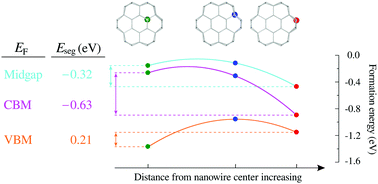Segregation tendencies of transition-metal dopants in wide band gap semiconductor nanowires†
Abstract
The segregation tendencies, defect energetics and electrical behavior of transition-metal (Mn and Co) dopants in wide band gap semiconductor (GaN and ZnO) nanowires are investigated by performing density-functional supercell calculations with the Hubbard U correction. Defect calculations and ab initio molecular dynamics simulations are carried out for a comparative exploration of various doping configurations where the dopant resides on interior, subsurface or surface sites. Mn and Co dopants in GaN and ZnO nanowires, respectively, are found to have different segregation tendencies: whereas a uniform distribution of Co dopants throughout ZnO nanowires takes place, indicating no segregation behavior, GaN nanowires can accommodate the majority of Mn dopants in the interior or surface sites, depending on the position of the Fermi level, which indicates not only segregation, but also that the direction of segregation can be reversed by shifting the Fermi level. Due to the latter, the Mn dopants can homogeneously be incorporated into the GaN nanowires only if the Fermi level remains in a certain range. A theoretically justified generalization of the segregation energy is imperative for obtaining these results, which are substantiated by comparison to experimental characterizations. Our findings demonstrate that the segregation tendency of an impurity in a semiconductor nanowire can be tuned by adjusting the position of the Fermi level (as in the case of Mn in GaN nanowires), which is, however, not always possible (as in the case of Co in ZnO nanowires). The analysis of the defect transition energies reveals that substitutional Mn and Co defects in GaN and ZnO nanowires form deep acceptor and deep donor levels, regardless of the doping site. This means that some other means such as codoping, stoichiometry control or gating must be used, if and as required, to shift the Fermi level of Mn-doped GaN or Co-doped ZnO nanowires in order to alter the type of electrical conduction and/or the segregation direction.

- This article is part of the themed collection: 2020 PCCP HOT Articles


 Please wait while we load your content...
Please wait while we load your content...